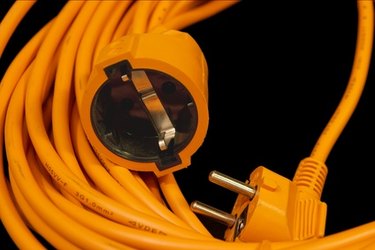Things You'll Need
240-volt cord suited to your needs
Plugs, both male and female
Electrician's screwdriver
Knife

Generators produce electricity; they also produce a lot of noise and poisonous carbon monoxide fumes. For safety reasons they are often located some distance from where the electricity is needed, so an extension cord caries the electricity from the generator to the appliances it powers. It is important to have the right extension cord, of the correct length, power rating and design for the conditions under which it is used. Making your own cord enables you to have a cord that meets your specific needs. It may also cost less than buying a commercially produced item.
Step 1
Select a cord of the appropriate characteristics. Electrical cord must meet ratings for indoor or outdoor use, for temperature range and for the maximum load it can safely carry. For example, to power a six-kilowatt heater from a 240-volt generator kept 30 feet from the house in a area where it snows in winter, you need at least 30 feet of 240-volt outdoor rated cable designed for winter use and with a wire gauge large enough to cope with the demands of the heater.
Video of the Day
Step 2
Calculate the maximum current your appliances will demand from the generator. Every appliance should have an information plate, showing its load in kilowatts, or kW. Divide the load, in watts, by the voltage. For example, with a 240-volt supply and a load of six kilowatts, the current demanded will be 6000 / 240, or 25 amps.
Step 3
Disassemble the plugs you will attach to the cord. Push several feet of cord through the housing on both plugs. This enables you to prepare the ends of the cord without the plug housings getting in your way.
Step 4
Position each plug base so the end of the cord is level with the terminals. Note where the cable grip lies, then, with a knife, remove the outer insulation from the cord from just beyond the position of the cable grip. Expose the internal wires but leave the insulation where the cable grip will hold the cord. Trim the ends of the wires so they reach the terminals without pulling or bunching up.
Step 5
Cut away the insulation to bare the final quarter of an inch of each wire. Twist together the exposed wire filaments within each wire to stiffen the ends.
Step 6
Connect the wires to the correct plug terminals. All generator cords must use polarized wiring, so using the correct terminals is essential. Connect the black or red "hot" wire to the brass terminal. Connect the white "neutral" wire to the silver terminal. The bare or green-covered grounding wire also must be attached, and it goes to the terminal marked as GND. The terminal may also be colored green.
Step 7
Fasten the cord firmly in the cord grips to protect the cord against being pulled loose from the plugs. Check that the terminals are tight and the wires are not trapped or lying where the plug top will crush them. Replace the top housing on each plug. The cord is now complete.
Tip
Extension cords are vulnerable to damage due to the conditions in which they are used. Always check extension cords before use, and replace or repair damaged parts immediately.
Before selecting the type of cord to use, research the local and national electrical regulations relating to generator extension cords. Some areas have specific guidelines on permitted types of cords and plugs.
Electrical and "do-it-yourself" stores can advise on suitable types of cord and plugs.
Some 240-volt cords are of European origin. European wires and plugs use a different color code. The grounding wire is called "earth", and is either green and yellow, or green and white. The "hot" wire will be brown and "neutral" will be blue.
Warning
Electricity can cause fires, injury and death. If you have any doubt, consult a qualified electrician and do not undertake "do-it-yourself" electrical projects.
The cord rating must exceed the maximum current your appliances will demand. If you use a smaller extension cord it will overheat and may catch fire.
Video of the Day